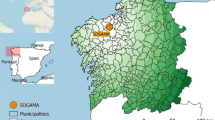Abstract
A considerable part of the total decomposable organic waste is treated in small-scale backyard composters. Nevertheless, as the scientific community mainly cares about large-scale composting facilities (including their end products), very few publications dealing with the specific problems connected with household composting are available. The results discussed in the present chapter clearly demonstrate that (1) even problematic organic material can be composted successfully in a comparatively short time in household composters (2) the best results concerning the course of composting and the endproduct are achieved by frequent mixing of the compost, together with applying chopped wood at a rate of 10%, and (3) further investigations on backyard composting are urgently needed, especially as the results of the interactions between different treatments of compost are still hardly predictable.
Access this chapter
Tax calculation will be finalised at checkout
Purchases are for personal use only
Preview
Unable to display preview. Download preview PDF.
Similar content being viewed by others
References
Anderson JPE, Domsch KH (1978) A physiological method for the measurement of microbial biomass in soils. Soil Biol Biochem 10: 211–221
Bardos RP, Lopez-Real JP (1991) The composting process: susceptible feedstocks, temperature, microbiology, sanitation and decomposition. In: Bidlingmaier W, L’Hermite P (eds) Compost process in waste management. European Community, Brussels, pp 179–190
Bishop PL, Godfrey C (1983) Nitrogen transformation during sludge composting. BioCycle 24: 34–39
Canet R, Pomares F (1995) Changes in physical, chemical, and physicochemical parameters during the composting of municipal solid wastes in two plants in Valencia. Biores Technol 51: 259–264
Choi MH, Park Y-H (1998) The influence of yeast on thermophilic composting of food waste. Lett Appl Microbio! 26: 175–178
DeSanto AV, Berg B, Rutigliano FA, Alfani A, Fioretto A (1993) Factors regulating early-stage decomposition of needle litters in five different coniferous forests. Soil Biol Biochem 25: 1423–1433
DeVleeschauwer D, Verdonck O, Van Assche P (1981) Phytotoxicity of refuse compost. BioCycle 27: 44–46
Eppstein E (1997) The science of composting. Technomic Publishing, Lancaster
Forster JC, Zech W, Wiirdinger E (1993) Comparison of chemical and microbiological methods for the characterization of the maturity of composts from contrasting sources. Biol Fertil Soils 16: 93–99
Iglesias-Jimenez E, Alvarez CE (1993) Apparent availability of nitrogen in composted municipal refuse. Biol Fertil Soils 16: 313–318
Ulmer P, Schinner F (1997) Compost turning — a central factor for a rapid and high-quality degradation in household composting. Biores Technol 59: 157–162
Ulmer P, Meyer E, Schinner F (1997) Thermic insulation and sieve plates — beneficial equipments for a rapid and high quality degradation in household composting? Bodenkultur 48: 99–103
Inbar Y, Chen Y, Hadar Y, Hoitink HAJ (1990) New approaches to compost maturity. BioCycle 31: 64–69
Kapetanios EG, Loizidou M, Valkanas G (1993) Compost production from Greek domestic refuse. Biores Technol 44: 13–16
Martin DL, Gershuny G (1992) The rodale book of composting. Rodale Press, Emmaus, USA
Mathur SP, Owen G, Dinel H, Schnitzer M (1993) Determination of compost biomaturity. I literature review. Biol Agric Hortic 10: 65–85
Oberfeld G (1996) Amtsärztliche Aspekte der Entsorgung biogener Abfälle. Mitt Österr Sanitätsverwalt 97 /4: 141–145
ÖNORM S2023 (1993) Untersuchungsmethoden and Güteüberwachung von Komposten. Österreichisches Normungsinstitut, Wien
ÖNORM S2200 (1993) Gütekriterien für Komposte aus biogenen Abfällen. Österreichisches Normungsinstitut, Wien
Pare T, Dinel H, Schnitzer M, Dumontet S (1998) Transformation of carbon and nitrogen during composting of animal manure and shredded paper. Biol Fertil Soils 26: 173–178
Paul EA, Clarke FE (1996) Soil microbiology and biochemistry. Academic Press, NewYork
Regan RW, Jeris JS (1970) A review of the decomposition of cellulose and refuse. Compost Sci 11:17–20
USEPA (1992) Characterization of municipal solid waste in the United States. 1992 Up date. EPA/530-S-92–019. US Environmental Protection Agency, Washington, DC
Wong MH (1985) Phytotoxicity of refuse compost during the process of maturation. Env Pollut Ser A 34: 159–174
Author information
Authors and Affiliations
Editor information
Editors and Affiliations
Rights and permissions
Copyright information
© 2002 Springer-Verlag Berlin Heidelberg
About this paper
Cite this paper
Illmer, P. (2002). Backyard Composting: General Considerations and a Case Study. In: Insam, H., Riddech, N., Klammer, S. (eds) Microbiology of Composting. Springer, Berlin, Heidelberg. https://doi.org/10.1007/978-3-662-08724-4_11
Download citation
DOI: https://doi.org/10.1007/978-3-662-08724-4_11
Publisher Name: Springer, Berlin, Heidelberg
Print ISBN: 978-3-642-08705-9
Online ISBN: 978-3-662-08724-4
eBook Packages: Springer Book Archive




